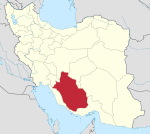world.wikisort.org - Iran
Khonj (Persian: خنج, also known as Khunj and Khunji)[2] is a city and capital of Khonj County, Fars Province, Iran. From the 2006 census, its population was 19,347, in 3,353 families.[3] It is located at an altitude of 670 metres (2,200 ft). Khonj was traditionally part of the region of Irahistan. The people of Khonj are native Persians of Zoroastrian origin who converted to Sunni Islam.
This article needs additional citations for verification. (January 2012) |
Khonj
خنج | |
|---|---|
City | |
 Khonj | |
| Coordinates: 27°53′29″N 53°26′04″E | |
| Country | Iran |
| Province | Fars |
| County | Khonj |
| Bakhsh | Central |
| Elevation | 670 m (2,200 ft) |
| Population (2016 Census) | |
| • Total | 32,451 [1] |
| Time zone | UTC+3:30 (IRST) |
| • Summer (DST) | UTC+4:30 (IRDT) |
Khonj is located 270 kilometres (170 mi) south of Shiraz. Its history goes back to 2,000 years, and Khonjis were known to be followers of Zoroastrianism. Khonjis refer to themselves as Khodmooni, a term literally meaning "part of ourselves" but figuratively used to refer to people from Gerash, Lar, Evaz, Khonj and other neighboring cities that share the Achomi language. The ancient names for Khonj were Hong and Konj (corner in Persian) and over time it has changed to Khonj. Its residents are Sunni, unlike most of Iran, and are famous as traders. The city has historical significance as it was the home for many Muslim scholars and great architects before and after Islam. Ibn Battuta, the great Moroccan explorer, wrote about his travels to Khonj in great detail.
The agriculture in Khonj is primarily wheat, oat, and dates. Khonj has the least amount of rainfall than any other part of Fars.

References
- "Statistical Center of Iran > Home".
- Khonj can be found at GEOnet Names Server, at this link, by opening the Advanced Search box, entering "-3071160" in the "Unique Feature Id" form, and clicking on "Search Database".
- "Census of the Islamic Republic of Iran, 1385 (2006)" (Excel). Statistical Center of Iran. Archived from the original on 2011-11-11.
На других языках
- [en] Khonj
[ru] Хондж
Хондж[1] (перс. خنج) — город на юге Ирана в провинции Фарс. Административный центр шахрестана Хондж. Население — 19 347 человек (2006)[2]. Основан примерно в I веке н. э., был одним из центров зороастризма и крупным купеческим городом. Хондж — крупнейший в исторической Персии суннитский город (большая часть персов — шииты). Климат — крайне сухой, Хондж — один из самых засушливых городов Ирана. Летом температура поднимается до 50°, зимой — нередко опускается ниже нуля.Другой контент может иметь иную лицензию. Перед использованием материалов сайта WikiSort.org внимательно изучите правила лицензирования конкретных элементов наполнения сайта.
WikiSort.org - проект по пересортировке и дополнению контента Википедии
